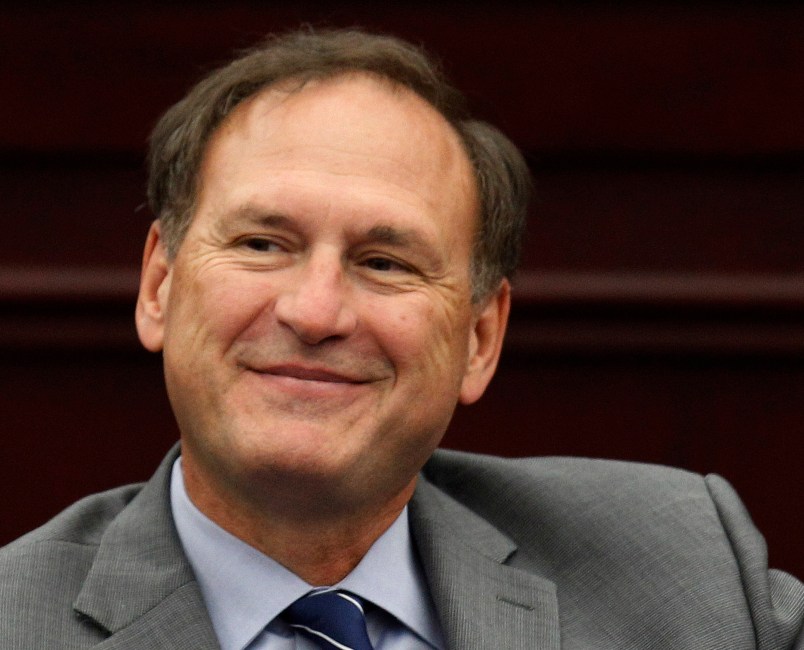The Supreme Court on Monday approved of Ohio’s voter purge protocol of removing people from the rolls if they sit out six years of federal elections and fail to return a card mailed to them by the state confirming their residency.
The 5-4 opinion was written by Justice Samuel Alito, with the four liberal justices dissenting. The conservative majority reversed an appeals court decision against Ohio’s system.
Monday’s decision will likely encourage other states to implement similar aggressive purge policies. The Ohio system puts voters who sit out just one presidential election and two midterms at risk for removal.
The Ohio policy allows election officials to begin the purge process once a voter does not vote in a certain period of time. Under the regime, if a voter sits out one federal election, they are sent a notification from the state inquiring whether they still reside at the same address. If the voter does not return the card and sits out the next four years of federal elections, Ohio then removes them from the voter rolls.
Opponents of the policy argued that it violated the National Voter Registration Act’s provision prohibiting the removal of voters “by reason of the person’s failure to vote.”
The conservative justices rejected that argument, with Alito writing that “Ohio removes registrants only if they have failed to vote and have failed to respond to a notice.”
Justice Stephen Breyer wrote the dissenting opinion for the liberal justices, and Justice Sonia Sotomayor also wrote her own dissent. Justice Clarence Thomas wrote a concurring opinion alongside the majority’s decision.
Breyer, in his dissent, pointed to statistics showing that a very small percentage of Americans — about four percent — move outside their county each year. Under Ohio’s voter purge regime, 1 millions voters, or 13 percent of those sent the confirmation cards, did not return them.
“Thus, I think it fair to assume (because of the human tendency not to send back cards received in the mail, confirmed strongly by the actual numbers in this record) the following: In respect to change of residence, the failure of more than 1 million Ohio voters to respond to forwardable notices (the vast majority of those sent) shows nothing at all that is statutorily significant,” Breyer wrote.
Alito, in his majority opinion, brushed off the argument that Ohio’s approach was not a reliable indicator that the voters had moved.
“What matters for present purposes is not whether the Ohio Legislature overestimated the correlation between nonvoting and moving or whether it reached a wise policy judgment about when return cards should be sent,” he wrote. “For us, all that matters is that no provision of the NVRA prohibits the legislature from implementing that judgment.”
Sotomayor, meanwhile, focused on the populations who, according to briefs filed in the case stand to be most likely to be purged under Ohio’s system: minority, low-income, disabled, and veteran voters.
“Neither the majority nor Ohio meaningfully dispute that the Supplemental Process disproportionately burdens these communities,” she wrote.
She said the majority’s opinion “entirely ignores the history of voter suppression against which the NVRA was enacted and upholds a program that appears to further the very disenfranchisement of minority and low-income voters that Congress set out to eradicate.”
“Communities that are disproportionately affected by unnecessarily harsh registration laws should not tolerate efforts to marginalize their influence in the political process, nor should allies who recognize blatant unfairness stand idly by,” she wrote.
Conservative activists who push for more restrictive voting laws were quick to cheer Monday’s decision.
“The days of trying to hamstring maintenance responsibilities in the absence of federal guidance are over,” J. Christian Adams — a member of President Trump’s now-defunct voter fraud commission — said in a statement.
Demos, the voting rights group that challenged Ohio’s voter purge law, said in a statement that the decision “threatens the ability of voters to have their voices heard in our elections.”
“The fight does not stop here. If states take today’s decision as a sign that they can be even more reckless and kick eligible voters off the rolls, we will fight back in the courts, the legislatures, and with our community partners across the country,” Demos senior counsel Stuart Naifeh said in the statement.







When you can’t win, cheat. When you can’t cheat, change the rules.
Thanks, Dead-ender Bernie Bros dickheads.
The agenda is moving forward.
And it’s just the beginning.
Thanks Bernie bros. and Stein sisters. It’s not like Hillary’s SCOTUS appointees would have made a difference or anything…
Those right wing supreme court justices are traitors too. All fucking dirty Republicans in this country are just the same.